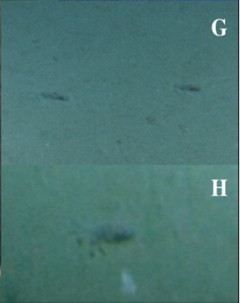 |
| Image from the Census of Marine life |
It was in all the papers! There was certainly some good criticism of what was accomplished but many argued that even though Cameron himself did not bring back very much, he did apparently make some collections which were studied by scientists at Scripps Institute of Oceanography in San Diego, California, and as explained by Deep Sea News' Holly Bik even mud from that depth holds the potential for interesting data (here).
So, here we are now THREE years later and one of the first papers detailing results from Cameron's Expedition has been published!! !
The OPEN ACCESS paper was published just recently in Deep Sea Research in the May 2015 issue, written by Natalya Gallo at Scripps Institution of Oceanography and a host of coauthors, including yes, director James Cameron.
Cameron famously descended in the one-man submersible, DeepSea Challenger to 10,000 meters where he took some video and grabbed some mud..
I saw him and his team as they stopped in DC on their way up to deposit the sub at Woods Hole Oceanographic awhile back...

This paper by Gallo et al. details not just his dive but ALL of the dives undertaken by the sub during the expedition to the region, including several of the world's deepest trenches, including the New Britain and the Mariana Trench (Challenger Deep). This totaled seven dives, five general dives and two into the trenches, overall ranging from 884 to 10,908 meters!
 |
| Figure 1 from Gallo et al. 2015 |
What do they report??
1. Organic input was different in the New Britain Trench
In the paper, there is what they call "allochthonous organic input" which is"science speak" for organic external or foreign materials that fall into the deep-sea which was seen more heavily near the New Britain Trench than the other regions sampled.
 |
| Figure 4 from Gallo et al. |
In contrast, the carrion in the form of bones, etc. contributed food or nutrients to the ecosystem..
I am always keen to remind folks how important what happens at the surface impacts what happens at the deepest depths. Note here at 1000 meters food still falls FROM THE SURFACE.
One of the more interesting finds was the observation of these starfish living on bones and woody debris at 8.2 kilometers down! (8200 meters!!)
These were identified as caymanostellids, a weird group of deep-sea starfish which live on wood. No scale was available but known examples of these sea stars are relatively small.
If these are truly from 8.2 kilometer depths, they might be the deepest individuals known for this group! WOO!
I've mentioned the deepest known records of OTHER starfish species here. Some of the deepest records are recorded from 8400 meters! So 8200 meters isn't much of a reach.
3. Lower abundance & diversity in nutrient poor canyons
 |
| Figure 7 from Gallo et al. |
This is the "on the other hand" of the study areas. The New Britain Trench (NBT) at 1000 m was nutrient rich but the Mariana Trench at the nearby Ulithi Atoll region (1100 m) were relatively poor in nutrients.
Correspondingly, the abundance AND diversity of animals observed was much less in the Mariana Trench and Ulithi Atoll regions.
The New Britain Trench site also seemed to demonstrate MORE diversity than the other two studied regions.
4. There is a large and diverse bottom/scavenging community in the New Britain Trench.
 |
| Figure 10 from Gallo et al. 2015 |
Looking at the number of amphipods in each video (per frame) they observed that there was a HUGE difference in the number observed!
Those in the New Britain Trench were MUCH more abundant!
Multiple species were likely present but this assemblage also apparently included the "supergiant" amphipod Alicella gigantea:
 |
| Image from the BBC |
One interesting thing: Absent from ALL the deep localites on this dive? NO FISH were observed. Its been argued that fish "bottom out" at about 8000 meters and are unable to occur below that.. The observations here seem to be consistent with this data.
5. Other animal observations.. Potentially new species??
Among the few animals observed at depth (from their Figure 9 below) were an odd ulmariid jellyfish (labelled C) as well many other crustaceans (D) which were either mysids or some kind of shrimp like crustacean..
One of the significant discoveries was this "squid worm", a swimming polychaete, likely in the genus Teuthidodrilus from 1 KM down in the New Britain Trench!! These were originally described from the Philippines.
In the Marianas trench at the deepest depth (10,900 meters!) they observed sea cucumbers oriented into the current, which is consistent with behavior seen in deep-sea sea cucumbers like sea pigs
The animals observed from the deepest point were only tentatively identified as members of the family Elpidiidae (Fig. 10 on the right G & H). They indicate these might possibly have been Peniagone sp. (Note Peniagone below is only for representative purposes and was NOT from Gallo et al.'s paper!)
 |
| Peniagone islandica from EOL |
Previously, the deepest known sea cucumber was Myriotrochus brunni which was collected from 10,710 meters in the Mariana Trench.
However, the account by Gallo et al. for the elpidiid sea cucumbers (their Fig. 10, G, H) are from 10,900 meters!! Which yes, makes them the DEEPEST known deuterostome animal!! (and certainly the deepest known echinoderm!!)






No comments:
Post a Comment